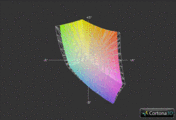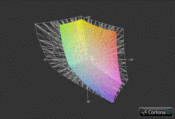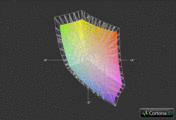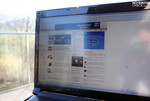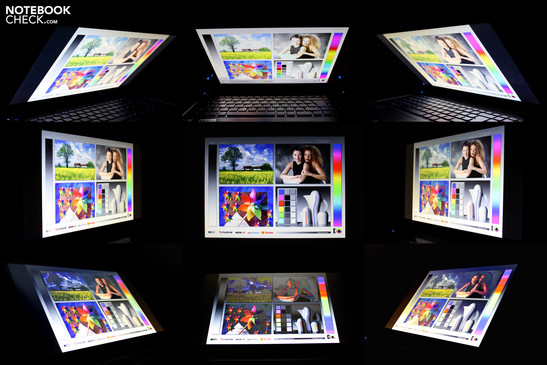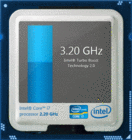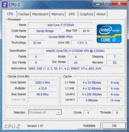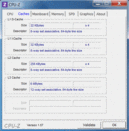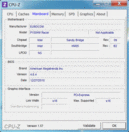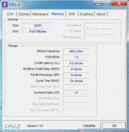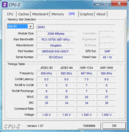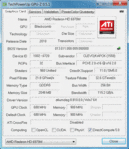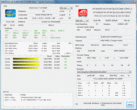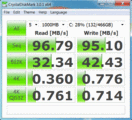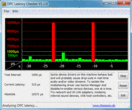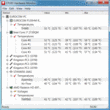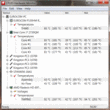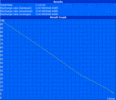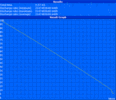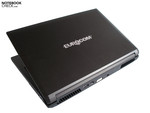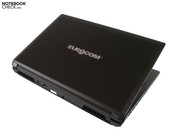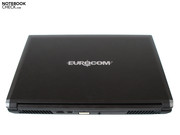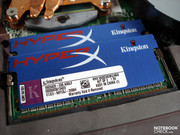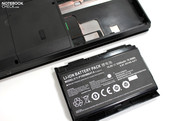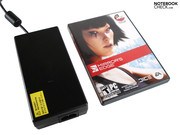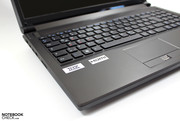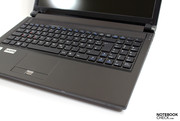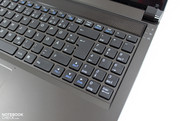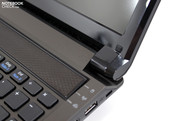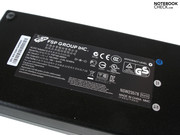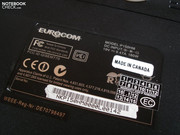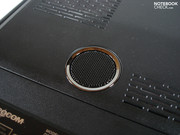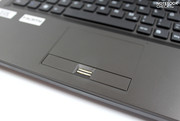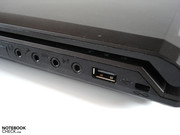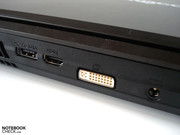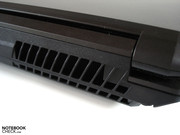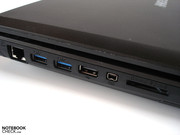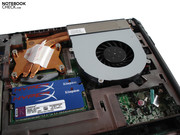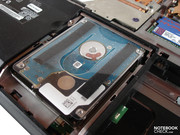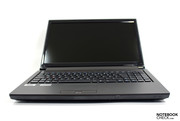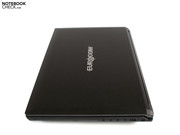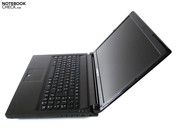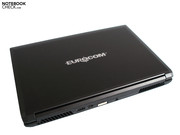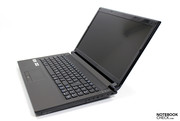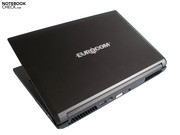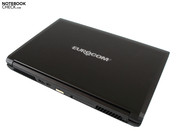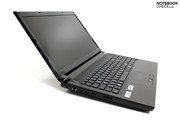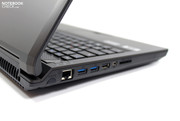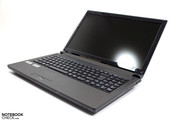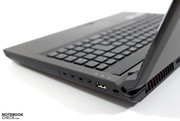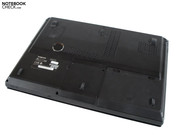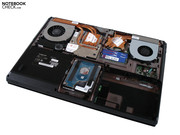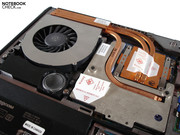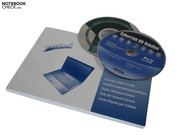Review Eurocom Racer Gaming-Notebook (2720QM / HD 6970M)
Aside from German manufacturers like Schenker and DevilTech, the Canadian company, Eurocom, is also starting to make use of Barebone notebooks from Clevo. The big advantage to Clevo Barebones is their extensive customizability. Unlike industry giants like Acer and Asus, you're not tied down to particular hardware combinations and can customize the notebook to your specific needs.
Only when choosing the type of hard drive can the decision be hard. Currently, a classic HDD or a hybrid can be a good choice, not to mention the speedy but still very expensive SSD. Next we have the processor, for which it comes as little surprise that Eurocom limits the choice to the second generation of Intel's uncommonly powerful Core i-series. These CPUs run the gamut from the dual-core Core i5-2520M with 2.50 – 3.20 GHz and 3 MB L3-cache to the quad-core Core i7-2920XM with 2.50 – 3.50 GHz and 8 MB L3-cache. As for the graphics card, the overwhelming majority comes from Nvidia. The notebook can come equipped with the GeForce GTX 460M, the GTX 470M, GTX 480M or even the GTX 485M, that is, the entire high-end collection.
As one of the few vendors of Clevo notebooks, Eurocom can also fit the notebook with an AMD graphics card on request. Our test notebook, for example, is equipped with the new top-of-the-line Radeon HD 6970M with a generous 2 GB GDDR5-VRAM. For the RAM we have the standard DDR3-RAM. We can't quite say much more about further customization options since the Eurocom notebook—most likely because of the delays caused by the Sandy Bridge chipset recall—will only be available starting 1 April and the website gives no further information about customizing the notebook.
Eurocom sets a good example in allowing international customers to choose the appropriate power cord and keyboard layout, the price appearing in Euros. The starting price for the Racer is predicted to be a fair 1100 Euro. Our test model with a Core i7-2720QM, Radeon HD 6970M, 8 GByte DDR3-RAM, 500 GB hybrid hard drive, Blu-Ray drive and Windows 7 Home Premium 64 Bit (see "Notebook Specifications" at the right for further details) comes to about 1800 Euro.
Since we've already reviewed the 3.1 Kg P150HM Barebone, measuring 376 x 256 x 49 mm, in the form of the mySN XMG P501, the sections discussing "Case", "Connectivity" and "Input Devices" are not included in this article. Just click on the above link for that information. Without further ado, we'll jump right to the display.
Display
The P150HM Barebone has a 15.6" display with a resolution of 1920 x 1080 pixels. This means that not only does the picture look razor sharp and clear but also that the Blu-Ray drive is worth the cost. Another interesting aspect of the display is the energy-saving LED backlight that more and more notebooks are being equipped with. It looks like Eurocom will be offering a screen with your choice of a matte or glossy finish as well as a 3D version (120 Hz instead of 60 Hz).
| |||||||||||||||||||||||||
Brightness Distribution: 81 %
Center on Battery: 235 cd/m²
Contrast: 603:1 (Black: 0.39 cd/m²)
60% AdobeRGB 1998 (Argyll 3D)
85.2% sRGB (Argyll 3D)
58% Display P3 (Argyll 3D)
Like the mySN XMG P501, the Eurocom Racer is also equipped with the high-end AUO11ED display (B156HW01 V1). The highlight of this screen is its incredibly high brightness of 237.8 cd/m² on average, leaving most of the competition out in the cold. Its brightness distribution of 81% is not the best, but the picture nevertheless looks quite evenly illuminated. The display deserves some additional praise for its excellent black level, the low 0.39 cd/m² makes for saturated blacks—unlike typical 08/15 displays, black areas on this display don't appear to have a noticeable gray tint. The fortunately low black level lends to a relatively good contrast ratio of 603:1. The picture therefore appears very rich in contrast, colors look very natural and vivid.
If you're planning on using the Eurocom Racer outdoors, do yourself a favor and choose the matte screen. Unlike with a glossy screen, a matte finish will prevent reflections from popping up and making the contents of the screen hard to interpret. Regardless of that, the high display brightness does a good job of counteracting irritating reflections on the screen, keeping the picture discernible. Using the laptop out on the porch or at an outdoor cafe should be no problem.
Even looking at the viewing angles, this display does not disappoint. Especially when looking at the screen from a sharp angle from the left or right, there's little distortion of colors or brightness. When tilting the screen back and forth, the picture gets distorted a good deal faster. Overall, the display leaves an excellent impression, The display even makes office work enjoyable with its crisp, bright picture, not just gaming or watching videos. An external monitor is unnecessary.
Note: Clevo is known for sometimes switching up the display their notebooks come with, which might mean a much lower quality screen (worst case scenario). But no need to fear, you can find the model number of the display using a wide array of tools (e.g. AIDA).
Performance
Processor: Intel Core i7-2720QM
When talking about CPU performance in the mobile sector, Intel currently has a clear lead on on the competition. The uncommonly powerful Sandy Bridge Architecture has made a huge leap compared the first generation of Core i-processors (see Review). Dual-core and quad-core processors of the Core i5 and Core i7 lines are available for the Eurocom Racer. We chose the Core i7-2720QM for our test model because this CPU has a great price-to-performance ratio and represents the perfect mate for the high-end GPU in place.
The Core i7-2720QM is a quad-core CPU manufactured in the 32 nm process and has over 995 million transistors. It runs at a base clock rate of 2.20 GHz, but the Turbo Boost function can automatically overclock the core to a maximum of 3.30 GHz. Moreover, the 6 MB L3-cache makes for some smooth gaming. Professionals will find the hyperthreading technology quite useful. In simulating four additional cores, the i7-2720QM is capable of processing a total of eight threads simultaneously, making multicore-optimized office applications run lightning fast. The on-board graphics card, the HD Graphics 3000, always remains inactive because there is no automatic or manual GPU-switching technology in place here.
CPU Performance
As previously mentioned, the older Core i-processors have no chance against their newer Sandy Bridge counterparts. The old popular Core i7-740QM (Eurocom W860CU Cougar), for example, has to admit defeat to the young blood. The performance difference is most easily seen in the Benchmark Cinebench R10 (64 Bit). With 5299 to 3793 points, the Core i7-2720QM manages a lead of about 40% in Singelcore Rendering. In Multicore Rendering the results are even more heavily in favor of the Sandy Bridge CPU, 18735 to 11033 points translate to a difference of 70%! In the newest of the Cinebench tests, Cinebench R11.5 (64 Bit), the Sandy-Bridge processor's lead dwindles a bit, but 63% is still huge (5.23 to 3.20 points). If you consider performance to be priority number one, there's currently no other way to go than a Sandy Bridge CPU.
| PCMark Vantage Result | 9653 points | |
Help | ||
Graphics Card: AMD Radeon HD 6970M
As opposed to the Radeon HD 5000 series, AMD is not advertising the brand new HD 6000 line under the ATI name. In order to make it easier to understand what kind of GPU you're dealing with, mobile graphics cards now come with an "M" at the end of the model number. Our test notebook came with AMD's current top model, the Radeon HD 6970M (Codename: Blackcomb XT), produced using the 40 nm process. The high-end graphics card is in direct competition with the Nvidia GeForce GTX 470M and GTX 485M. It brings to the table 960 unified shaders as opposed to the old Radeon HD 5870's 800. With the new HD 6970M, AMD has reached their target clock rates of 680 and 900 MHz for the core and memory, respectively. There's even a whole 2 GB of speedy GDDR5-VRAM, connected at an appropriate 256 bits.
In terms of its specs, the Radeon HD 6970M is impressive across the board, but compared to Nvidia GPUs, AMD is a bit lacking the features department. Of course, the Radeon HD 6970M does have a video decoder (UVD3), an HD audio controller and a capability to render separate pictures on multiple monitors (Eyefinity), 3D rendering (HD3D) is, however, not nearly as well developed as Nvidia's 3D Vision. GPU-based physics acceleration (PhysX) is not to be found in the Radeon HD 6970M. This shouldn't be too much of a big deal to most gamers since the GPU's DirectX 11 support is the most important feature. The main problem with the Radeon HD 6970M is, however, its high energy consumption. The GPU can consume up to 100 watts.
GPU Performance
In running the graphics benchmarks, our main objective was to see, whether the Radeon HD 6970M performs more like the GeForce GTX 470M (DevilTech Fragbook DTX, Core i7-2630QM) or rather the GeForce GTX 485M (mySN XMG P501, Core i7-2630QM). Starting with 3DMark Vantage (GPU Score), in which the Radeon HD 6970M—with 11501 points to 8787 points—places way ahead of the GTX 470M (+31%), ranking in just behind the GTX 485M (12208 points).
In the 3DMark 11 benchmark (GPU Score) the Radeon HD 6970M takes the lead this time with 2834 points. While the GTX 485M is outstripped by 6% (2668 points), the GTX 470M must bow its head in shame, trailing 44% behind (1970 points). The Unigine Heaven 2.1 benchmark—which puts a good deal of focus on tessellation (a core feature of DirectX 11)—happens to greatly favor Nvidia GPUs. At 40.9 to 33.2 fps, the GeForce GTX 485M ranks in a whole 23% ahead of the Radeon HD 6970M, which to its credit still manages to outdo the GeForce GTX 470M by 12% (29.6 fps).
| 3DMark 03 Standard | 58788 points | |
| 3DMark 05 Standard | 24871 points | |
| 3DMark 06 Standard Score | 19382 points | |
| 3DMark Vantage P Result | 12838 points | |
| 3DMark 11 Performance | 3120 points | |
Help | ||
Hard Drive
If a conventional HDD sounds too old to you, the Eurocom Racer can also be fitted with an SSD or—like in our case—a hybrid model. The Seagate Momentus XT (ST95005620AS) in place here has a storage capacity of 500 GB and runs extrememly fast thanks to its rotational speed of 7200 RPM, giving it a very good average transfer rate of 85.0 MB/s (HDTune). The sequential read rate (96.79 MB/s) and the sequential write rate (95.10 MB/s) are likewise quite formidable (CrystalDiskMark). Only when dealing with very small files does the hard drive's speed drop significantly. In this respect, the hybrid hard drive has no chance against a full-fledged SSD.
Verdict: Performance
This high a level of performance is a rare find in the notebook sector. Hardly any application out there can make the Eurocom Racer break a sweat—Intel's Core i7 processors of the Sandy Bridge generation really pack a wallop. Combined with a high-end graphics card like the Radeon HD 6970M and 8 GB RAM, the user is well equipped for any task. If you can afford it, choosing the SSD version is worth some consideration since it substantially speeds up Windows functions, booting up the computer, loading times and transfer rates.
Now we come to the gaming benchmarks. Once again, the Radeon HD 6970M must lock horns with its fiercest rivals, the GeForce GTX 470M (DevilTech Fragbook DTX, Core i7-2630QM) and the GeForce GTX 485M (mySN XMG P501, Core i7-2920XM). In order to minimize the influence of the CPU on the results, we ran all games in the full-HD resolution of 1920 x 1080.
Mafia 2
The sequel to the good old gangster epic from 2K Czech (formerly Illusion Softworks) starts off our benchmark obstacle course. High details and 16x AF (anisotropic filtering) aren't much of a challenge for the Radeon HD 6970M. At 55.9 fps, our AMD follows at the heels of GeForce GTX 485M (58.3 fps). The GeForce GTX 470M, however, is outshined by a whole 21% (46.1 fps).
| Mafia 2 | |||
| Resolution | Settings | Value | |
| 1920x1080 | high, 0xAA, 16xAF | 55.9 fps | |
Call of Duty: Black Ops
Although the Call of Duty series hasn't brought many innovations to the table in recent years, Black Ops is nevertheless a fun play and a big cash cow. The Radeon HD 6970M is the perfect choice for rendering the scenic first-person shooter. Very high details, 4x AA (antialiasing) and 8x AF result in a thoroughly smooth 74.5 fps. The GeForce GTX 485M follows shortly behind with 71.4 fps, and the GeForce GTX 470M takes 3rd place with 64.1 fps.
| Call of Duty: Black Ops | |||
| Resolution | Settings | Value | |
| 1920x1080 | extra, 4xAA, 8xAF | 74.5 fps | |
Starcraft 2
In order to fluidly play this real-time strategy with the highest graphics settings on, it takes a some powerful hardware. The Radeon HD 6970M is up to the task and renders the game with "Ultra" detail settings at an average refresh rate of a very smooth 58.6 fps. While the GeForce GTX 485M yet again trails slightly (56.5fps), and the GeForce GTX 470M is about 30% behind (41.1 fps).
| StarCraft 2 | |||
| Resolution | Settings | Value | |
| 1920x1080 | ultra | 58.6 fps | |
Metro 2033
The highly detailed world of Metro 2033 was, technically speaking, one of the gems of 2010. Very high details, DirectX 11 mode, AAA (Analytical Antialiasing) and 4x AF currently suffocate even the best mobile graphics cards. The Radeon HD 6970M doesn't stand out much here with a mere 18.3 fps, not nearly enough for smooth game flow. The competition from GeForce has just as hard of a time, neither the GTX 485M (16.1 fps, -12%) or the GTX 470M (12.1 fps, -34%) don't manage anything nearly playable.
| Metro 2033 | |||
| Resolution | Settings | Value | |
| 1920x1080 | Very High DX11, AAA, 4xAF | 18.3 fps | |
| 1600x900 | High DX10, AAA, 4xAF | 52 fps | |
Battlefield: Bad Company 2
Bad Company 2 is one of the most popular multi-player shooters currently out there. With high details, 4x AA and 8x AF most notebooks end up gritting their teeth in frustration. The Radeon HD 6970M, however, manages an incredibly fluid 49.7 fps, giving it a 33% lead over the GeForce GTX 470M (37.5 fps). The GeForce GTX 485M is nevertheless on par with the new AMD at 49.5 fps.
| Battlefield: Bad Company 2 | |||
| Resolution | Settings | Value | |
| 1920x1080 | high, HBAO on, 4xAA, 8xAF | 49.7 fps | |
Risen
It was recently announced that the sequel to the popular RPG Risen will take on a pirate motif. If you haven't finished the first by the release date, the Eurocom Racer is the perfect way to play the first. With high details and 4x AF, the Radeon HD 6970M manages an excellent 46.8 fps, landing it a spot 11% behind the GeForce GTX 485M (52.7 fps), but 23% ahead of the GeForce GTX 470M (38.2 fps).
| Risen | |||
| Resolution | Settings | Value | |
| 1920x1080 | high/all on, 0xAA, 4xAF | 46.8 fps | |
Need for Speed: Shift
Zooming by in your tricked out racer through realistically scenic courses just about summarizes Need for Speed Shift. High details and 4x AA are no longer much of a test for high-end graphics cards. With a very smooth 64.6 fps, the Radeon HD 6970M doesn't miss one frame of even the sharpest turn. While the GeForce GTX 470M can't quite keep up (55.7 fps, -14%), the GeForce GTX 485M wins out by 9% (70.7 fps).
| Need for Speed Shift | |||
| Resolution | Settings | Value | |
| 1920x1080 | all on/high, 4xAA, triliniarAF | 64.6 fps | |
Colin McRae: Dirt 2
Whether riding through mud in a big ol' truck or on the streets of Tokyo in a pimped out street racer, Dirt 2 definitely favors Nvidia graphics cards. With very high details and 4x AA, the Radeon HD 6970M manages a good 50.3 fps but is outstripped by both the GeForce GTX 470M (53.9 fps, +7%) and the GeForce GTX 485M (70.3 fps, +40%). Taking a look at the results of the Unigine Heaven benchmark, we quickly came to the conclusion that the GeForce 400 series handles DirectX11 a good deal better than the the Radeon HD 6000 series.
| Colin McRae: DIRT 2 | |||
| Resolution | Settings | Value | |
| 1920x1080 | Ultra Preset, 4xAA | 50.3 fps | |
Verdict: Gaming Performance
The Eurocom Racer manages an overall excellent gaming performance. The AMD Radeon HD 6970M is powerful enough to smoothly run most recent titles in high resolutions with the highest detail settings including graphics enhancers (AA & AF). The graphics-rendering power encased here competes with the best of them and is in no way worse off than a full-fledged desktop PC. It's remarkable how much power can be contained within a comapact 15" case these days. Only with extremely resource-demanding games like Metro 2033 or Crysis do the graphics settings or the resolution have to be bumped down a notch for fluid gameplay.
Nvidia may be in for a fight for its title as king of the hill. Despite the much lower price of the Radeon HD 6970M, it's performance nearly matches that of the GeForce GTX 485M. The Nvidia card ends up running games a mere 7% faster on average. As far as Eurocom goes at least, the equally priced GeForce GTX 470M is easily crushed by the AMD Radeon HD 6970M, which renders about 28% faster overall. Regarding its price-to-performance ratio, the Radeon HD 6970M is some really hot stuff. It's only a shame that not every vendor of Clevo notebooks gives customers the option of choosing an AMD graphics card.
| low | med. | high | ultra | |
|---|---|---|---|---|
| Crysis - GPU Benchmark (2007) | 76.7 | 25 | ||
| Crysis - CPU Benchmark (2007) | 74.1 | 23.3 | ||
| Far Cry 2 (2008) | 57.2 | |||
| F.E.A.R. 2 (2009) | 86.8 | |||
| Colin McRae: DIRT 2 (2009) | 50.3 | |||
| Need for Speed Shift (2009) | 64.6 | |||
| Resident Evil 5 (2009) | 80 | |||
| Risen (2009) | 46.8 | |||
| CoD Modern Warfare 2 (2009) | 76.9 | |||
| Battlefield: Bad Company 2 (2010) | 49.7 | |||
| Metro 2033 (2010) | 52 | 18.3 | ||
| StarCraft 2 (2010) | 58.6 | |||
| Mafia 2 (2010) | 55.9 | |||
| Fifa 11 (2010) | 171.4 | |||
| Call of Duty: Black Ops (2010) | 74.5 |
Emissions
System Noise
The extremely loud system noise is the biggest downside of the Eurocom Racer. In idle mode, the fans already make their presence known, accenting simple tasks like office work and using the internet with audible background noise. Under heavy use the level of noise rises to the point of becoming irritating. Without headphones or the speakers set to a high volume, films and games can become overshadowed by the whirring of the fans.
Those sensitive to noise will want to steer clear of the Eurocom Racer, even though the variety of halfway quiet gaming notebooks is very limited. The Asus G73SW is one of the rare exceptions. With the GeForce GTX 485M in place, the P150HM Barebone is equally loud under heavy use, although the fans remain a good deal quieter in idle mode (mySN XMG P501).
Noise level
| Idle |
| 34.8 / 34.8 / 35.3 dB(A) |
| HDD |
| 34.8 dB(A) |
| DVD |
| 36.7 / dB(A) |
| Load |
| 44.9 / 46.6 dB(A) |
 | ||
30 dB silent 40 dB(A) audible 50 dB(A) loud |
||
min: | ||
Temperature
As opposed to the system noise, there's nothing to gripe about regarding the case temperature. In idle mode as well as under heavy use, the case surface remains cool to the touch, not exceeding 33°C – kudos.
The palm rest stays especially cool, not warming up beyond 22°C. This translates to hours of comfortable gaming. In the GeForce GTX 485M version, it's a different story, however. The mySN XMG P501 heated up to a much higher max of 38°C (base unit top) and 46°C (base plate).
Taking a look inside didn't reveal much of anything surprising. The processor reached a max of 87°C and the graphics card 94°C, relatively high values. Still these temperatures were reached during the course of the non-real-world Furmark and Prime95 stress test. During normal gaming sessions (regardless how long) the components don't quite get so hot.
(+) The maximum temperature on the upper side is 29.8 °C / 86 F, compared to the average of 40.4 °C / 105 F, ranging from 21.2 to 68.8 °C for the class Gaming.
(+) The bottom heats up to a maximum of 32.5 °C / 91 F, compared to the average of 43.3 °C / 110 F
(+) In idle usage, the average temperature for the upper side is 22.6 °C / 73 F, compared to the device average of 33.9 °C / 93 F.
(+) The palmrests and touchpad are cooler than skin temperature with a maximum of 21.7 °C / 71.1 F and are therefore cool to the touch.
(+) The average temperature of the palmrest area of similar devices was 28.8 °C / 83.8 F (+7.1 °C / 12.7 F).
Speakers
The 2.1 sound system in place here leaves a decent impression. The two speakers found above the keyboard are complemented by a subwoofer tucked away in the base plate. The best feature is its high max volume, making all types of media easily audible from a distance. Other than that, the sound produced is muffled and wishy-washy, that is, not very crisp. At high volumes we also observed a certain distortion in the sound. The sound quality is good enough for a short listen, but we'd use external speakers for longer periods of time. Those not wanting to have to hook up the laptop to an external sound system should consider the Asus G73SW, the MSI GT663R or the Medion Erazer X6811.
Battery Life
Although the Eurocom Racer is equipped with a powerful 8-cell battery(76.96 Wh, 5200 mAh), its battery life is quite short. Under heavy use (like in the Classic Test from Battery Eater), with max screen brightness and energy-saving options deactivated, the laptop shuts off after 60 minutes.
When playing a DVD (max brightness, moderate energy-saving settings) the battery power still only lasts a meager 72 minutes, not nearly enough to finish watching a typical film. Using the internet via WiFi (Firefox 3 with Adblock), only 2 hours can be squeezed out. Turning the screen brightness all the way down and the energy-saving settings all on doesn't much help cordless use, we measured 2 hours 15 minutes in the Reader's Test from Battery Eater.
To complement the fierce performance of the high end hardware we have some pretty high levels of energy consumption going on. Compared to the GeForce GTX 485M, the Radeon HD 6970M doesn't quite save energy as well in idle mode. While the mySN XMG P501 (with very similar hardware) eats up 26.6 – 31.7 watts, the Eurocom Racer manages to suck down 30.7 – 37.5 watts. Under heavy use, the energy consumption comes to 120.4 – 175.5 watts (Eurocom Racer) compared to 125.1 – 180.2 watts (mySN XMG P501) --this time just about equal, the Radeon HD 6970M being just a tad more efficient.
| Off / Standby | |
| Idle | |
| Load |
|
Key:
min: | |
Verdict
The Eurocom Racer has truly earned the distinction of desktop replacement. The combination of a brand new Sandy Bridge processor and a high-end graphics card with support for DirectX11 is not overwhelmed even by the most resource-demanding games. Particularly impressive is the price-to-performance ratio of the Radeon HD 6970M. For the price of a GeForce GTX 470M, you get performance akin to the GeForce GTX 485M.
Aside from its pure power, the Eurocom Racer makes a great impression in other departments as well: from the large variety of well-placed ports (2x USB 3.0) to the good keyboard and compact case with its matte black, rubberized and always-cool surfaces, the list goes on. The Eurocom Racer scores some more points with its high-quality display. As opposed to a typical 08/15 display (as is sadly the current standard), the colors, contrast and black value leave nothing to be desired, making it possible to experience games and films in their full brilliance.
Some pitfalls prevented the Eurocom Racer from receiving a rating of "Very Good", however. The worst thing is its high level of noise, the fans become particularly loud under heavy use. Aside from that, there's still room for improvement in terms of case sturdiness and battery life.
All in all, the Eurocom Racer is a compact, high-quality and extremely powerful gaming notebook that's definitely worth some thought for hardcore gamers.





